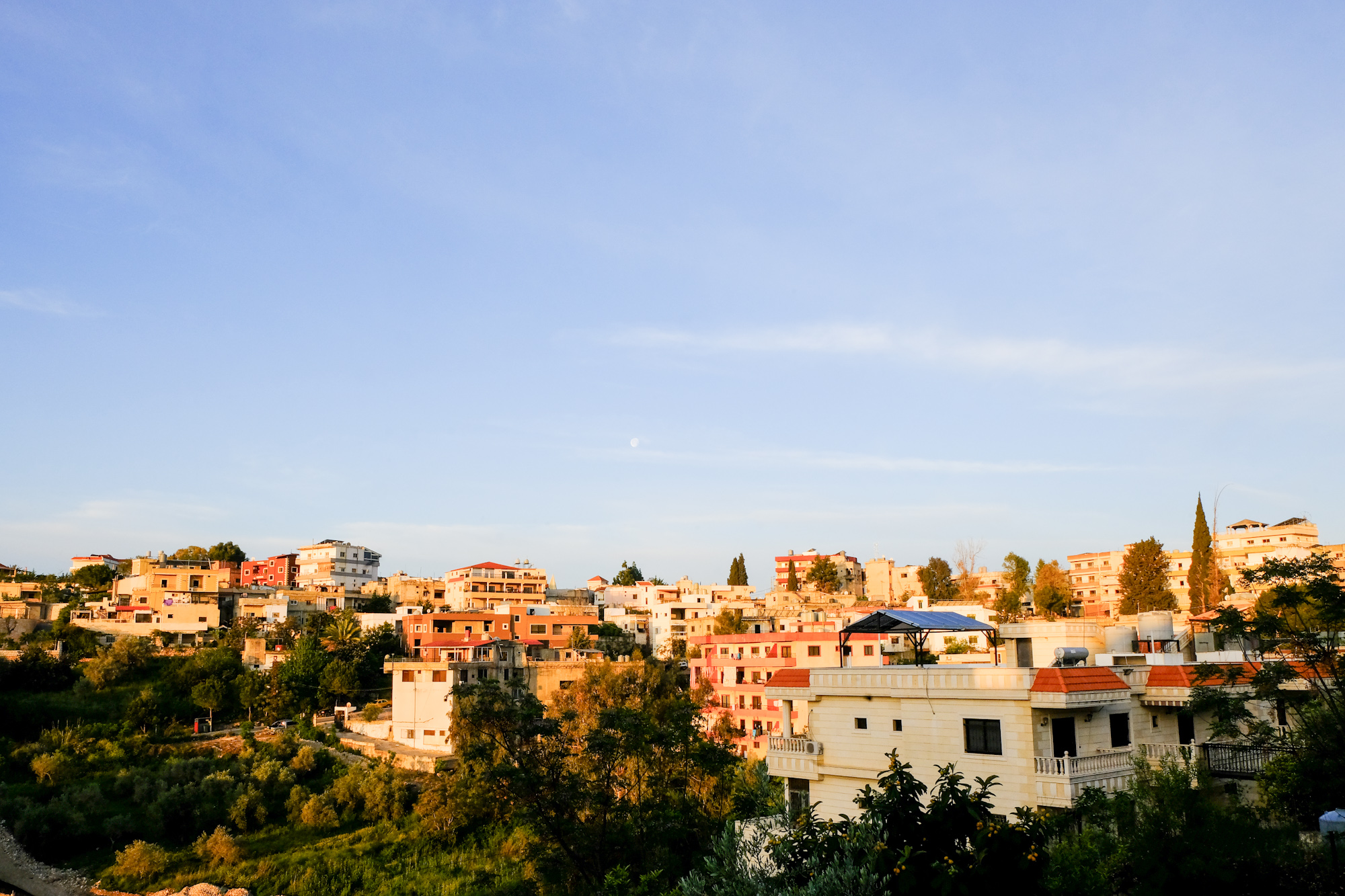ZAATAR NEAR THE BORDER
TEXT: JENNY GUSTAFSSON
PHOTOS: JENNY GUSTAFSSON
RESEARCH: ANGELA SAADE
EDITS: NISREEN KAJ
Harvesting zaatar, an herb deeply rooted in Lebanese and Palestinian food traditions, in fields in the south
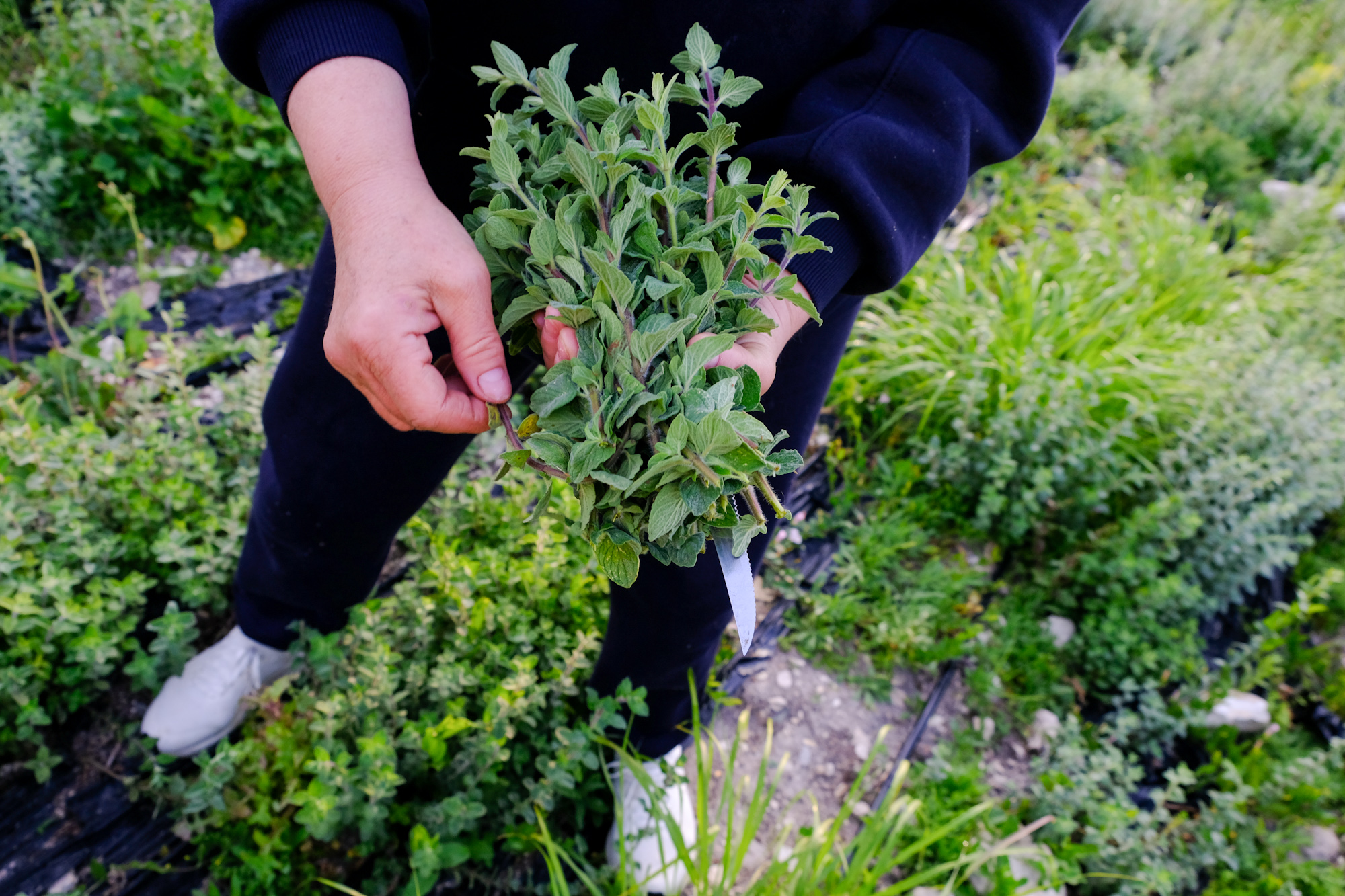
ZAATAR, ESSENTIAL IN THE LEBANESE – AND THE PALESTINIAN – KITCHEN
It is early morning and barely light outside when a group of women arrives at a small field on the outskirts of Qana, a town in the hilly countryside of southern Lebanon. They wear sneakers and comfortable clothes, and carry a stack of empty black vegetable crates.
The ground beneath their feet is rocky and covered with green plants. There is grass and different kinds of weeds, but also growing among the stones and leaves, the much-loved herb that is the reason for their coming here today: zaatar.
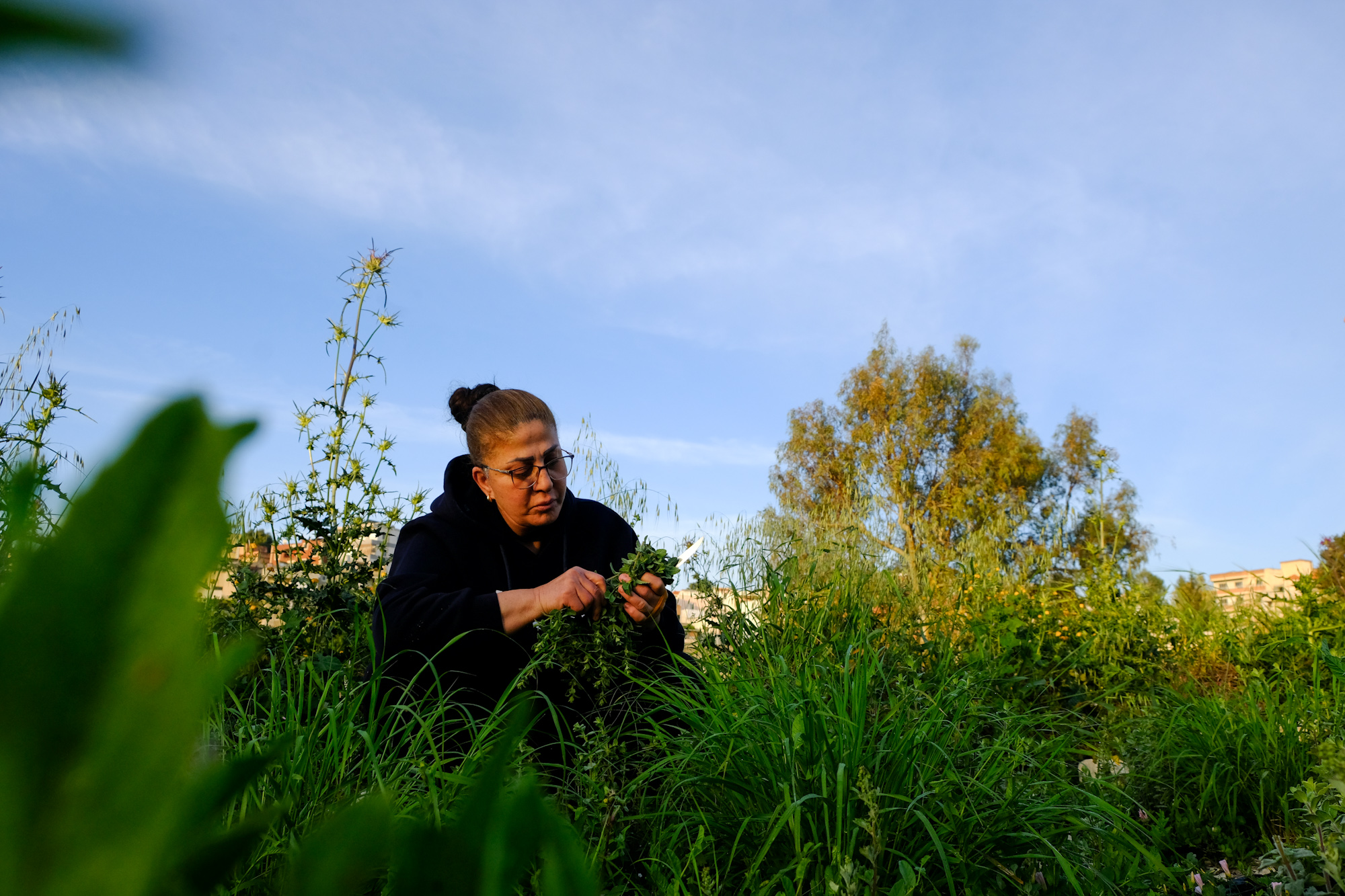
One of the women, Suzane Attieh, grabs a bunch of fine stalks growing closely together on the ground, cuts them with a knife at the base, and arranges them in her hand. She leans down to pick more; soon, she has a thick and leafy bouquet.
“The south is known for its zaatar. Sure, you find it elsewhere in Lebanon too, but we are very connected to it here,” says one of the other women, Majida Boutros.
She also holds a green bunch in her hands, tied together with a rubber band. She takes a couple of steps, walks over to one of the crates, and drops the zaatar in.
The women continue picking herbs as the sun slowly rises in the sky. They are five, all part of an agricultural cooperative in the village. Two of them – Majida and Suzane – are co-founders of the cooperative, which is women-led and was officially established in 2011 (though it began work in 2007). There is also Ghada Boutros, Majida’s sister, and two others, a woman who prefers to use the name Um Ibrahim and her daughter, Nour, who are hired specifically for the harvest.
“Zaatar has three seasons. In winter we pick green zaatar, then there’s a season starting in June and another one in September,” Majida says.
Qana, with its dry climate and hilly topography, is an ideal spot to grow zaatar. The herb grows here in the wild, where people forage it for their own consumption, and on plantations like this land, where it is cultivated to be sold on the market. Some zaatar is eaten fresh, but most of it will be dried and mixed with sesame seeds and sumac to make herb mixes also known simply as zaatar.
“The zaatar we grow is the zoube3 kind,” Majida says, pointing to the small, bushy, pale green plants growing around her feet.
Zaatar, despite being talked about in the singular, is in reality more than that. It is a generic name for a number of different herbs belonging to the larger Lamiaceae botanical family, which includes plants like lavender, sage, oregano, rosemary, and thyme.
The Qana cooperative picks zaatar early in the morning, when the air in the fields is still cool
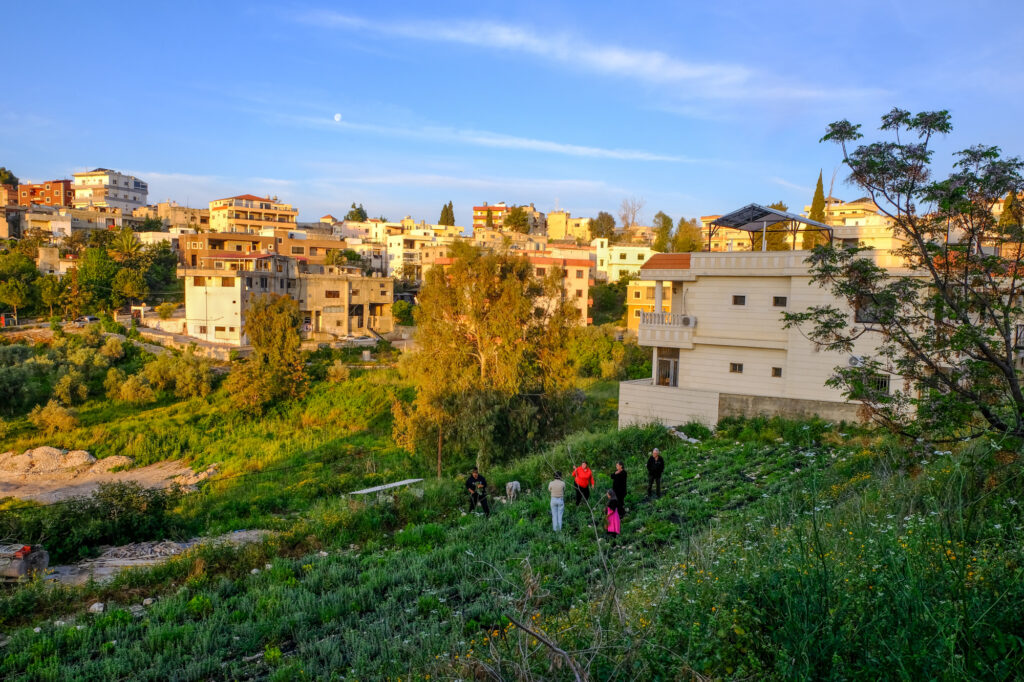
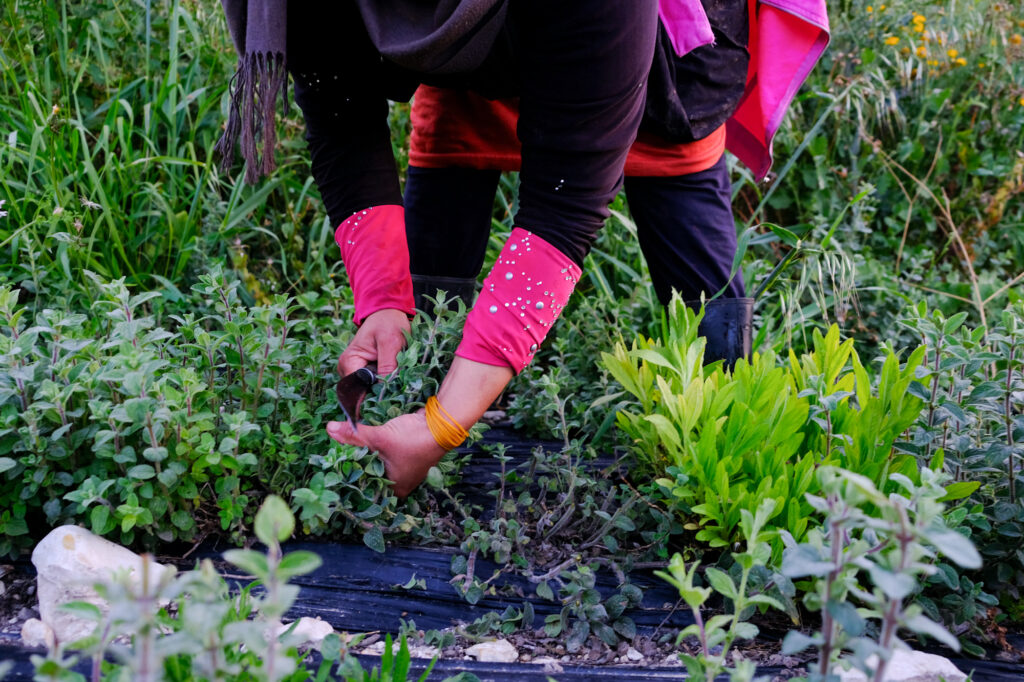
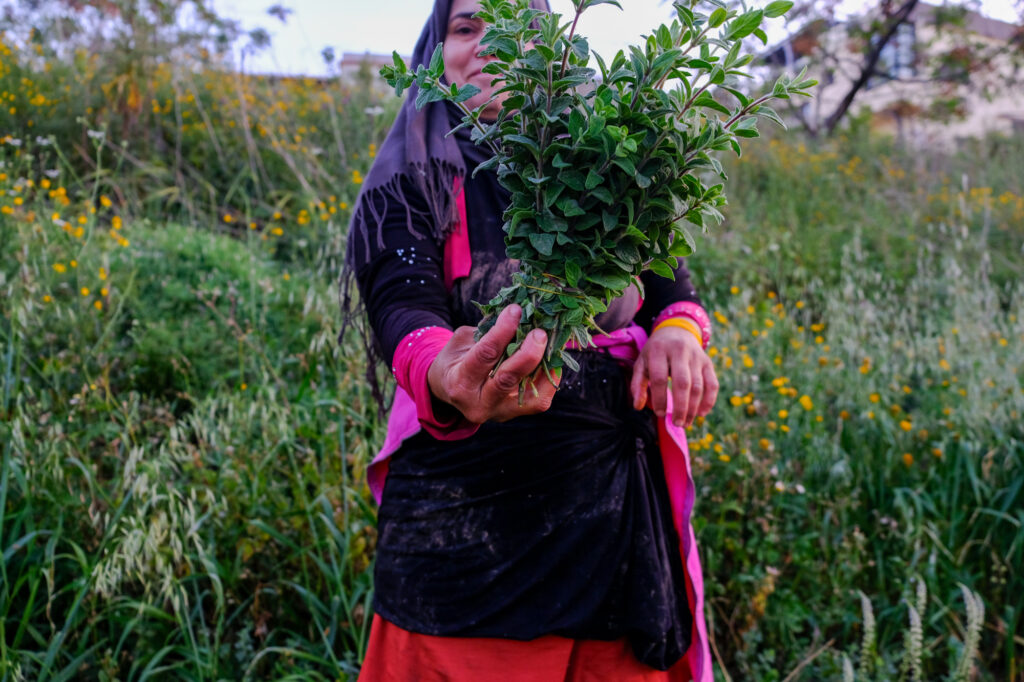
Most zaatar picked in Lebanon, including the cooperative’s zoube3, is either origanum syriacum (sometimes called “Lebanese oregano” or “Syrian oregano”) or origanum ehrenbergii, both varieties of oregano that are native to Lebanon and the larger eastern Mediterranean. This zaatar has soft, almost feather-like, leaves that are tiny and rounded and great for drying.
Zaatar might also be any of a number of different kinds of wild thyme, which are sturdier and have long, thin leaves. This zaatar, when not dried, is often added to salads, typically with rocca (arugula or rocket) leaves and onion.
The most popular way to eat zaatar is arguably in its dried form, mixed with olive oil and spread on top of manouche dough, then baked for a few minutes in a large oven. These zaatar mixes vary, but almost all include sesame seeds and sumac, a tangy spice made from the pulverized berries of the sumac plant. There are also blends like zaatar Halabi (Aleppo zaatar), with a much longer list of ingredients, such as pomegranate molasses, pistachios, fennel, and coriander. At bakeries across Lebanon, it is not uncommon for people to bring their own zaatar – harvested and dried at home – to use instead of the bakery’s.
When the UN’s Food and Agriculture Organization, FAO, published a standard for zaatar in 2020, it listed four botanical genera that may appear in dry zaatar mixes: origanum, thymbra, thymus, and satureja. Each of these four, on its own, is the parent of several different kinds of herbs.
In Lebanon (and elsewhere in the region), names overlap and vary. Besides zoube3, there’s also zaatar da22 or di22i – words that come from the same root as dukkah, the name for different mixes of herbs, nuts, and spices eaten in the region, most commonly in Egypt. Many Lebanese also simply say zaatar barri (wild zaatar) when referring to the foraged plants.
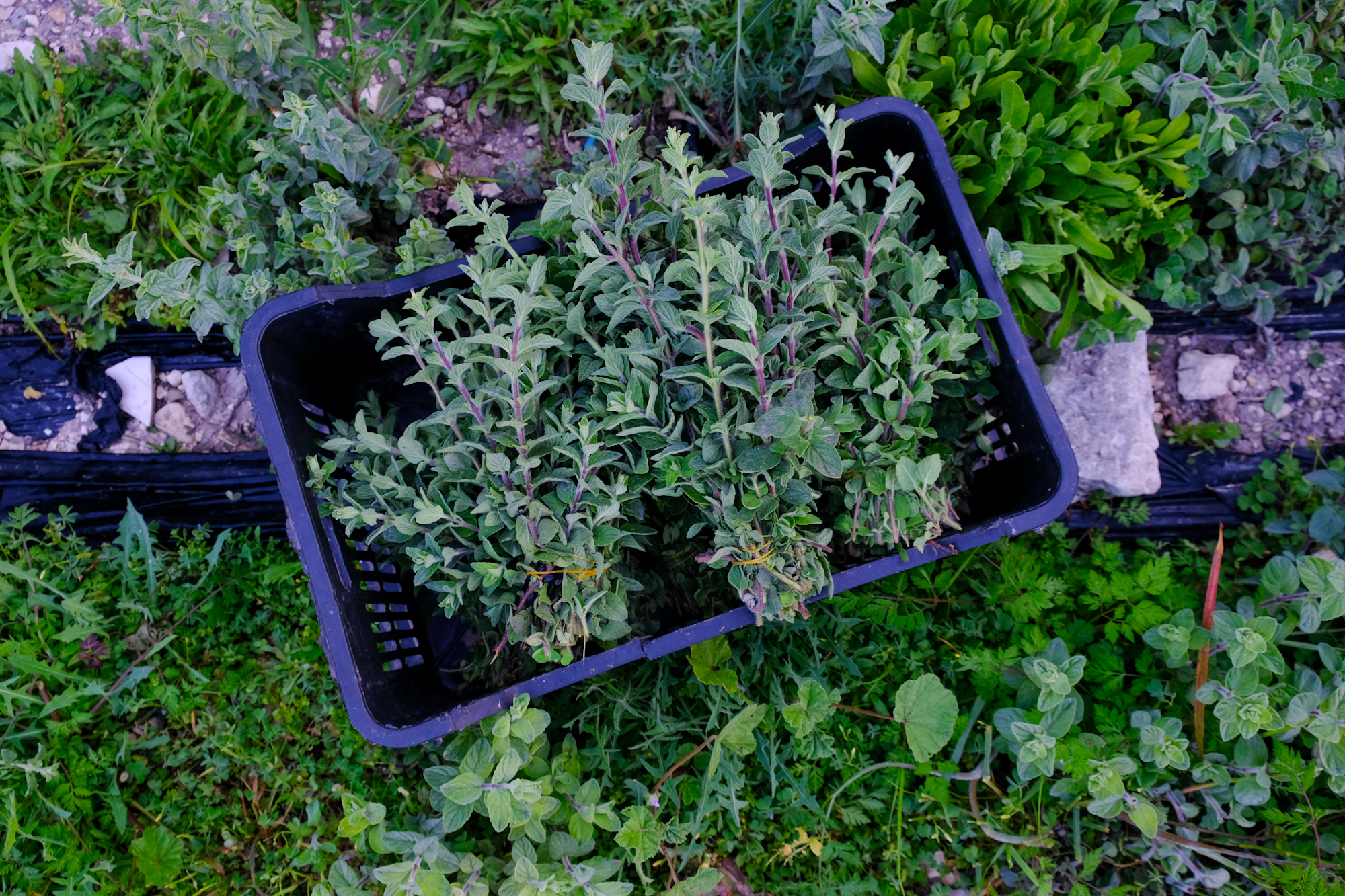
Bundles of zaatar, harvested in the early morning hours
What is certain is that these different herbs form part of the region’s social and culinary history. The origanum family, for instance, is a Mediterranean herb group: 35 of its 43 species only occur in the eastern Mediterranean (and four solely in the western Mediterranean). The herbs grow mainly in mountainous areas, not necessarily at high altitudes but preferably on stony slopes. Indeed, the name origanum, made up from the Greek words oros (mountain or hill) and ganos (joy, celebration), translates to “joy of the mountains”.
The southern Lebanese landscape, with its soft hills and rocky lands, continues in a similar manner in Palestine, where zaatar holds equal, if not more, significance. Just like the Lebanese, Palestinians have been foraging and eating zaatar throughout history. These herbs and the histories connected to them have come to represent the Palestinian people’s belonging to their country, linking them directly to the land from which they are forced away. “As long as there’s zaatar and olives, we will remain,” a saying goes.
Mahmoud Darwish, who has chronicled many aspects of Palestinian culture in his writings, mentions zaatar in his poem Ahmed al Zaatar, written in the aftermath of the 1976 Tel al Zaatar massacre in Beirut. “For two hands, of stone and zaatar,” he writes, “I dedicate this song, for Ahmad, forgotten between two butterflies.” Edward Said, in a 1986 conversation with Salman Rushdie, said, when talking to his author friend about breakfast, that “It is a sign of a Palestinian home that it has zaatar in it.” (More recently, chef Fadi Kattan said, “Zaatar is what you have on the breakfast table in every Palestinian home, wherever they are across the world.”)
Ismail Haniyeh, the now assassinated former leader in Hamas, evoked the political importance of zaatar when he famously said, in a 2006 speech, that “We will eat zaatar, grass, and salt, but we will not give in or renounce our principles.”
Decades earlier, in 1977, the Israeli government – when Ariel Sharon was the minister of agriculture – imposed a ban on the harvest of wild zaatar. Foragers, if found with plants, were fined or had their herbs confiscated. The stated reason was environmental: that zaatar was in risk of becoming extinct.
But the ban was largely seen – and served – as a move to target Palestinian culture, heritage, and economic life. It also coincided with a sharp increase in Israeli cultivation of zaatar: an example of the colonial practice of erasing what is seen as “wild” and instead transforming such heritage into schemes that benefit the colonizer.
In the realm of food, this practice has a long history in Palestine.
Um Ibrahim and Antoine Haddad, Majida Boutros’ husband, keep some zaatar aside for their families, not to be sold
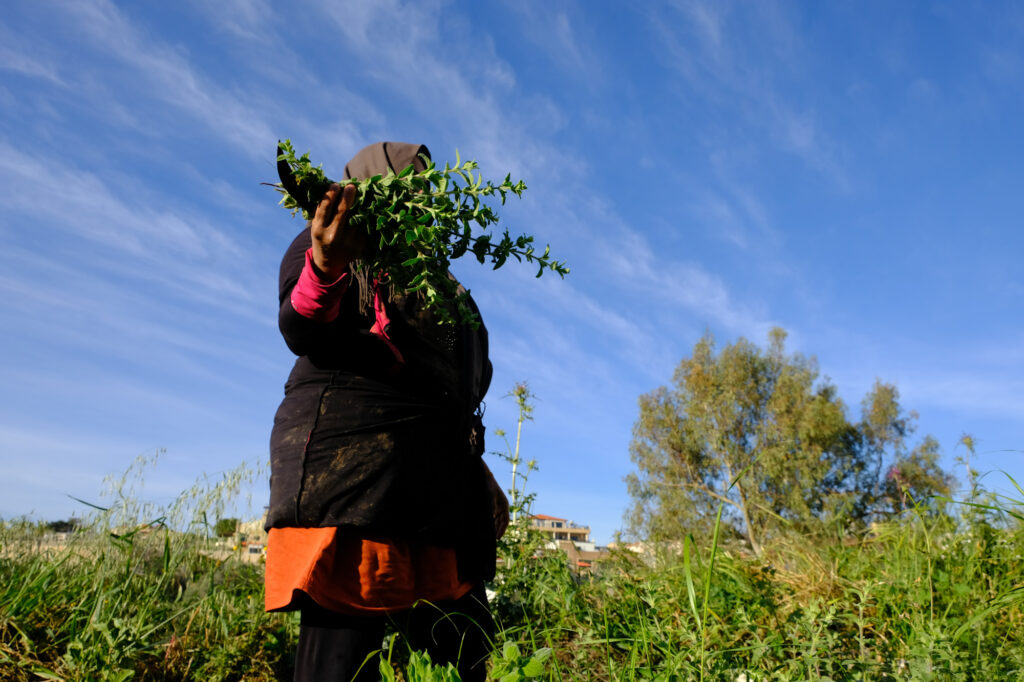
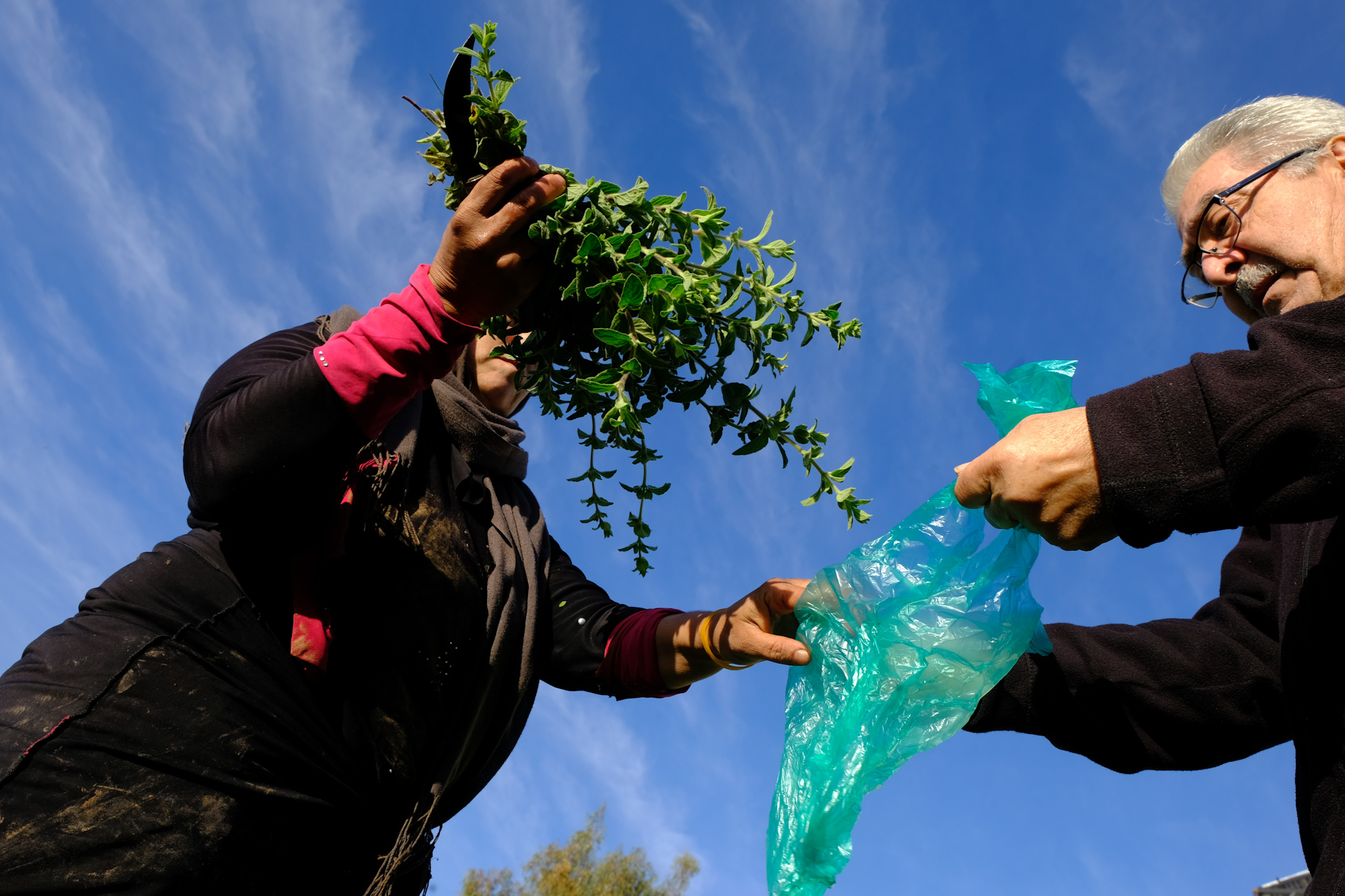
Zaatar was already mentioned in the 1936 cookbook published in English and German, with Hebrew translations, on behalf of the Women’s International Zionist Organization, called How to Cook in Palestine. The introduction calls for housewives to “free” their kitchens from “European customs which are not applicable to Palestine.” Zaatar, or, as the book says, “the lovely thyme,” is listed as one example of plants to start growing. Mint is another, which the authors believed should not “be used only by the Arabs” but also “planted in the Jewish colonies.”
There are other cases of Israeli laws targeting Palestinian culinary and agricultural heritage as well, such as the 2005 ban on foraging akkoub (another significant wild plant), and the criminalization in the 1950s of owning and herding black goats (the most common livestock animal in Palestine before 1948).
On the other side of the border, in Lebanon’s south, food and agricultural practices have come under different forms of attack since Israel’s genocide in Gaza started in October 2023. Land has been directly targeted, trees have been uprooted and destroyed, and people have been stopped from tending to their lands and harvesting their crops.
The World Bank recently published an estimate of US$6.8 billion in damage and US$7.2 billion in economic losses. Lebanon’s two southernmost governorates, Nabatieh and the South, were the most affected.
“They destroyed everything in our region. Churches, mosques, agricultural lands, trees, houses. Everything,” says Faten Serhan.
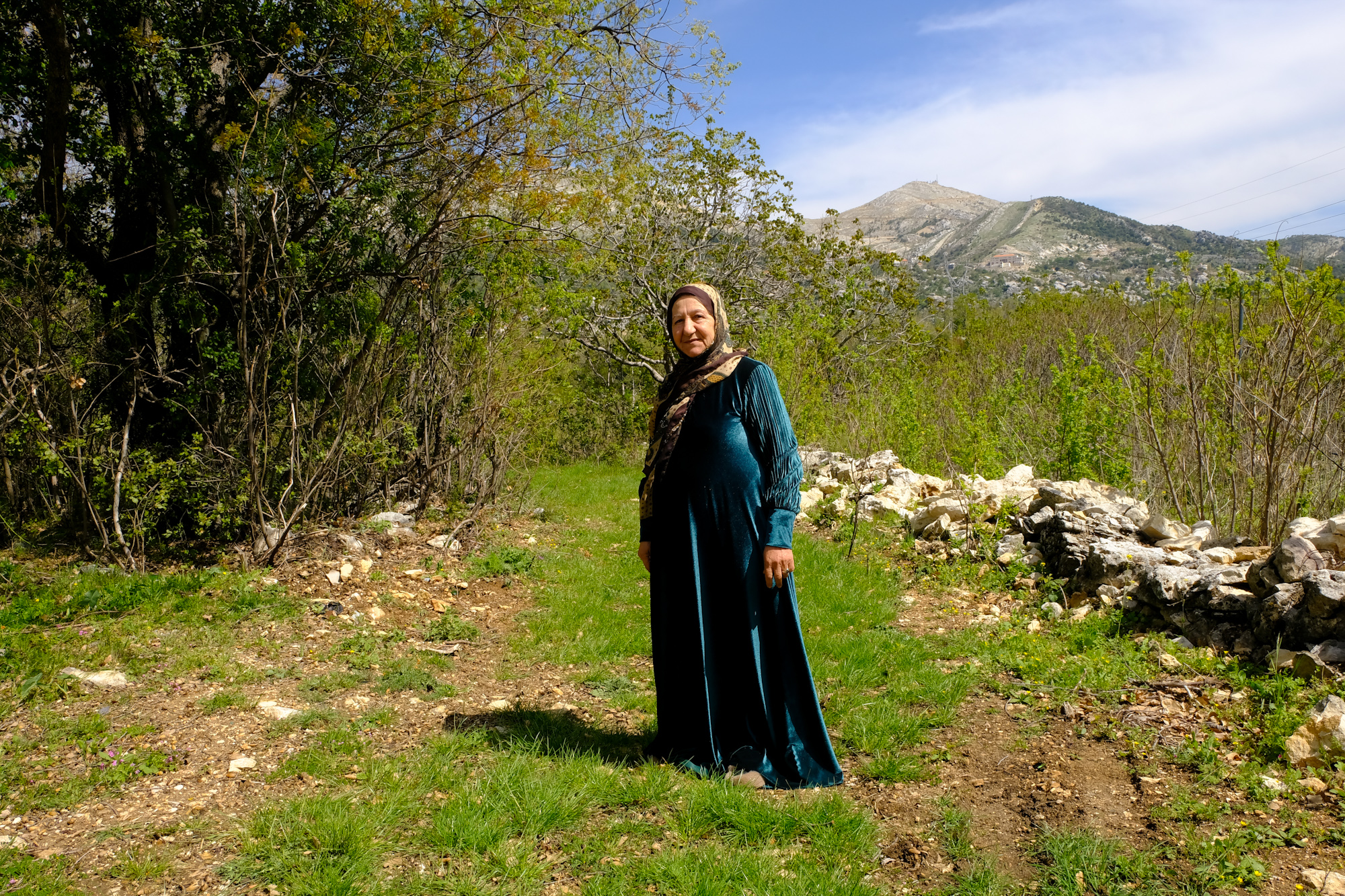
Afife Serhan, who comes from the town of Kfarkela, where she grows many different crops and vegetables
She sits on the sofa in a bright living room in the mountain town of Jezzine, with views over the rocky slopes just outside the window. Next to her sit her mother, Afife Serhan, and her brother, Mohammad Serhan. The family came to Jezzine when life in their home village of Kfarkela, right on the southern border and among the worst-hit during the war, became too dangerous.
“At some point, we started seeing people dying, one after another,” Mohammad says.
“The last time I was in Kfarkela, for a funeral, I stopped to water the trees near our house. Soon enough, I realized I had forgotten some, but I thought to myself, ‘No worries, I can do that tomorrow.’ Then, when I came back the next day, every single tree was gone. They had bombed the village that morning.”
He grabs a small cup of coffee that was brought out on a tray from the kitchen.
“We had been using all our available water to try and save the life of our trees and land. We had managed to keep everything alive until that moment,” he says.
The family grows many things on their land in Kfarkela, including olives and all kinds of vegetables. Afife’s other son, Ali, runs a popular Instagram account, My Land, where he shares videos of his mother cooking and spending time on the land. The family also has a restaurant where they serve the food they grow.

Suzane and Majida, founders of a zaatar-growing cooperative in Qana
“We don’t use chemical fertilizers; we believe in natural methods. When you plant with good intentions, everything grows well,” Afife says.
They grow zaatar as well, on a piece of land next to their house.
“The one we have is rainfed, which means the zaatar has more aroma. It loses some of its character when irrigated. Zaatar doesn’t like too much water, and it needs sun,” she says.
“We have both regular zaatar and the thin, tall zaatar diqqi, which we use in certain dishes to add flavor. It’s very good to eat with shanklish,” Mohammad says.
Afife says that, most of all, she likes to eat zaatar mixed with olive oil, spread on top of her own bread. Majida prefers it the same way.
“We just mix the zaatar with olive oil and some salt. Whether fresh or dried, it’s best that way,” she says.
The cooperative in Qana makes biscuits and crackers with zaatar, which they sell in Beirut and elsewhere, as well as manouche made from their own wheat flour. They also prepare their own dry mixes.
“We usually make a special blend for ourselves, different from the one we sell. It has less sesame so that the zaatar flavor stands out more. And we add extra sumac, because when you bake zaatar on a manouche in the oven, the sourness of sumac disappears a bit,” Suzane says.
When Israeli airstrikes began devastating towns and villages across the south, Qana was one of many that came under attack. The sisters and others in the cooperative had to flee, like people all over the south. At the peak in November last year, 900,000 people, one fifth of Lebanon’s population, were displaced across the country.
“Some of us went to stay with relatives. Others rented places or sheltered in schools and churches,” Majida says.
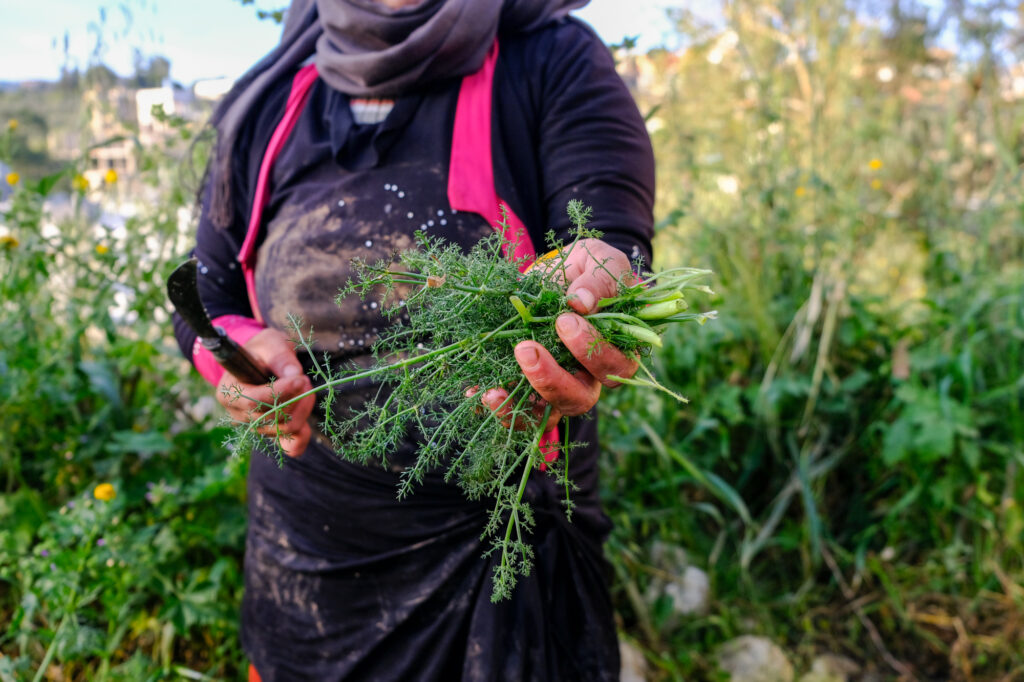
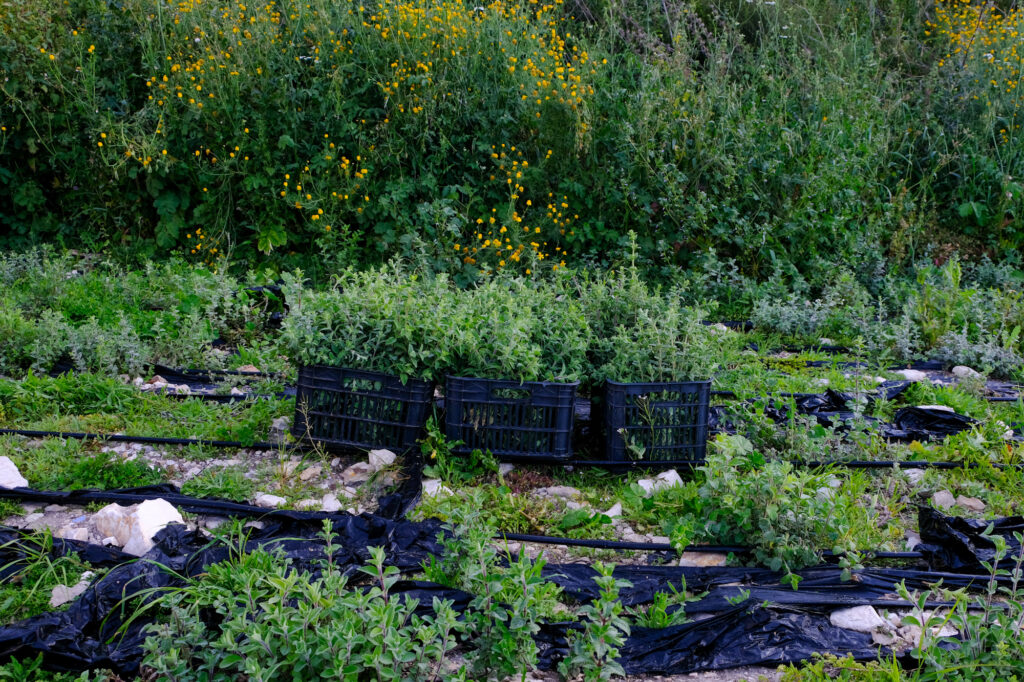
Um Ibrahim bundles zaatar together, to be sold by the Qana cooperative
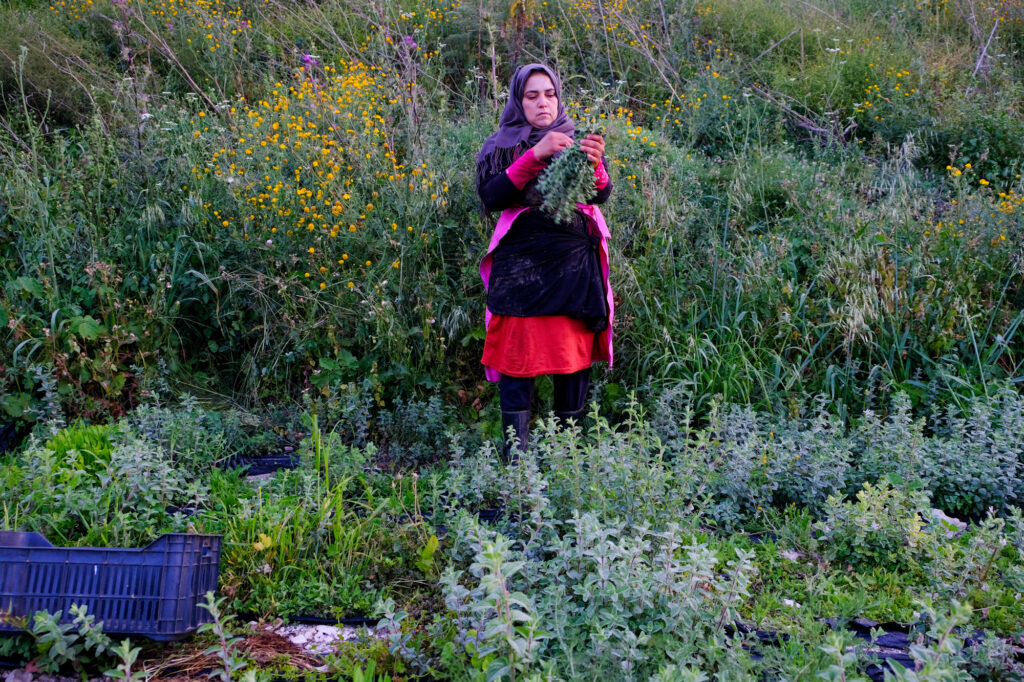
“We were forced to leave in 2006 as well, but it was different this time. We were evacuating with bombs falling around us. There was even an explosion going off right next to the car,” she says.
When the women were able to return to Qana, they found many of their plants dead. They had not been directly targeted, but dried out from the lack of water.
“They had been left for two months without any care. We managed to find a few surviving plants, which we uprooted and planted on another piece of land so they could be saved,” Suzane says.
The cooperative also grows their own wheat to make bulghur and flour used for their bread. But this year, they weren’t able to plant any at all.
“We missed the season because of the war. And when we finally had time to plant, we didn’t even find any seeds,” Suzane says.
In Kfarkela, the situation is far worse. Much of the village is heavily destroyed, with many homes entirely reduced to rubble.
Satellite images and other photos show devastation where life – both human and botanical – used to be.
“This is not the first time Israel targets Kfarkela, far from it. The village was one of the first in Lebanon to be occupied, in 1978,” Mohammad says.
Four years later, in 1982, Israeli forces returned and began an occupation of southern Lebanon that continued until 2000. During this era, people’s social, political, and economic independence was constantly violated. It was only possible to leave and re-enter the region through Israeli-controlled checkpoints set up on Lebanese soil.
Mohammad says that the period damaged people’s connection to the land.
“Everything was destroyed during the occupation. The older generation left with their children; many went abroad to live and study. It created a gap of over 20 years, during which the new generation lost its connection,” he says.
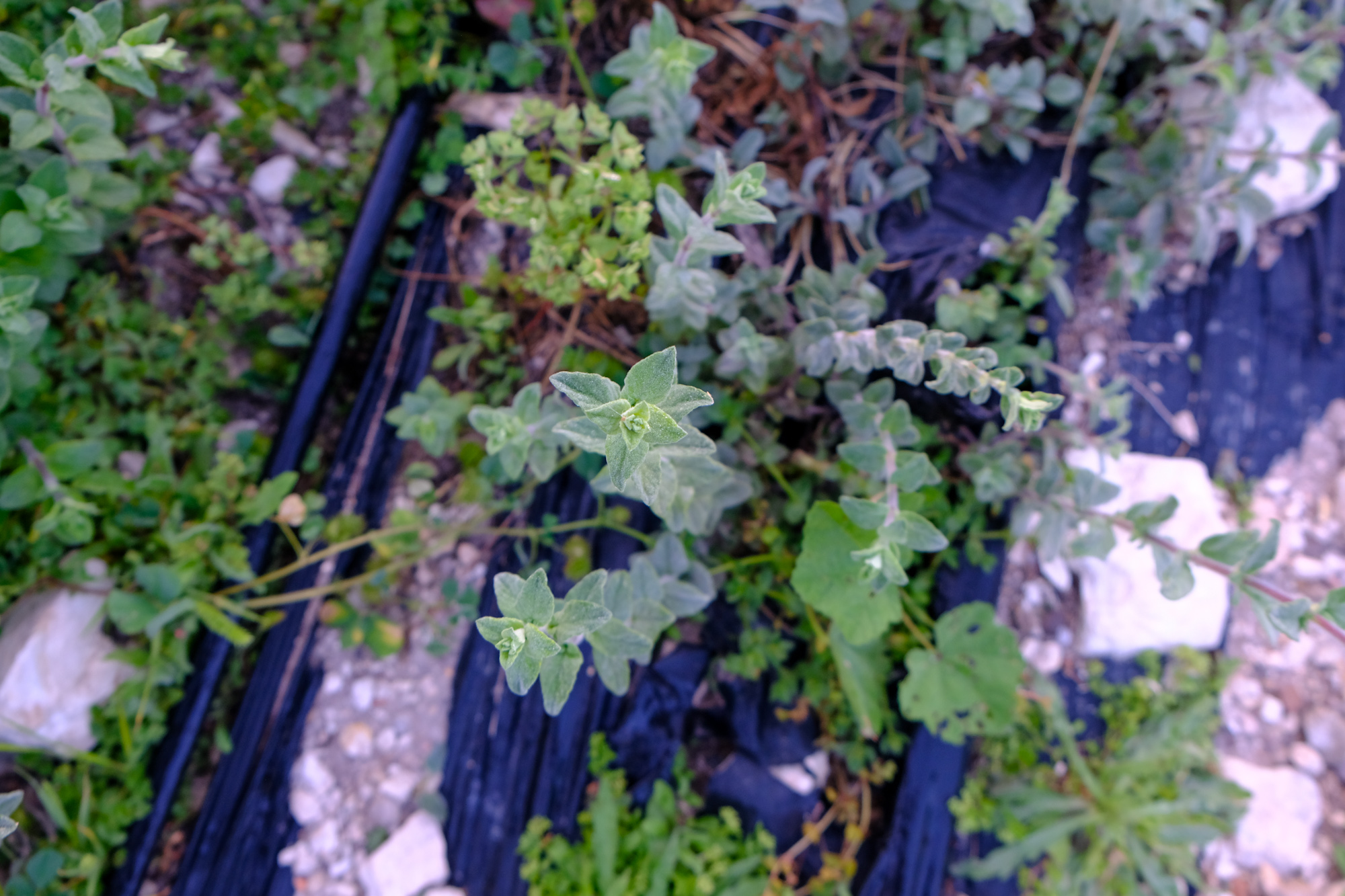
“I was the only one in the family who stayed in the village at the time. I sent the children to Beirut but remained in the house, to show that someone was there,” Afife says.
Majida says her family in Qana went through similar things.
“During the 2006 war, my mother agreed to leave, but not my father. Even in 1996, when UNIFIL came to escort those evacuating, he avoided them and returned home. During this war, neither of them left,” she says.
The oppressive policies enforced during the occupation were an attempt at slowly destroying agriculture in the south. Vegetables and other produce could no longer move freely, while goods brought over from Israel took over the market. Citrus was left to rot on the trees, as farmers never knew whether their fruits would reach buyers in Beirut and the north.
Afife and her family were forced to leave their home and land in Kfarkela, and have stayed in the mountain town Jezzine since the Israeli attacks began

Before the current war, that lethality hit southern Lebanon most recently in 2006. Afife describes how she fled Kfarkela during the month-long war in the summer of that year.
“At first, we stayed. But after 17 days, we were told we should leave. And I was afraid. My daughter was only six years old at the time. We drove to the Bekaa, right as they were bombing cars behind us,” she says.
Afife and her children did not have the restaurant back then; it was first opened during the pandemic. Since then, they have kept it running, even in times of uncertainty.
“People keep asking for homemade products like our mouneh preserves and zaatar. We have had guests coming from Kuwait, Nigeria, the USA, Saudi Arabia, and other countries,” Afife says.
The zaatar they serve and sell mainly comes from the wild, not the plants growing near their house. After trees were planted nearby, the zaatar gets too much shade and no longer grows well.
“So, we started hiring people to go and harvest in the wild instead, which is the best-tasting zaatar anyway,” Afife says.
Cultivated plants differ from those that grow in the wild, as does zaatar picked during the blooming period.
“Some people like the intense flavor of blooming zaatar while others prefer the milder taste of leafier zaatar. It is common to use both in mixes,” Ghada says.
Even if zaatar grows naturally in the south, cultivating it requires effort.
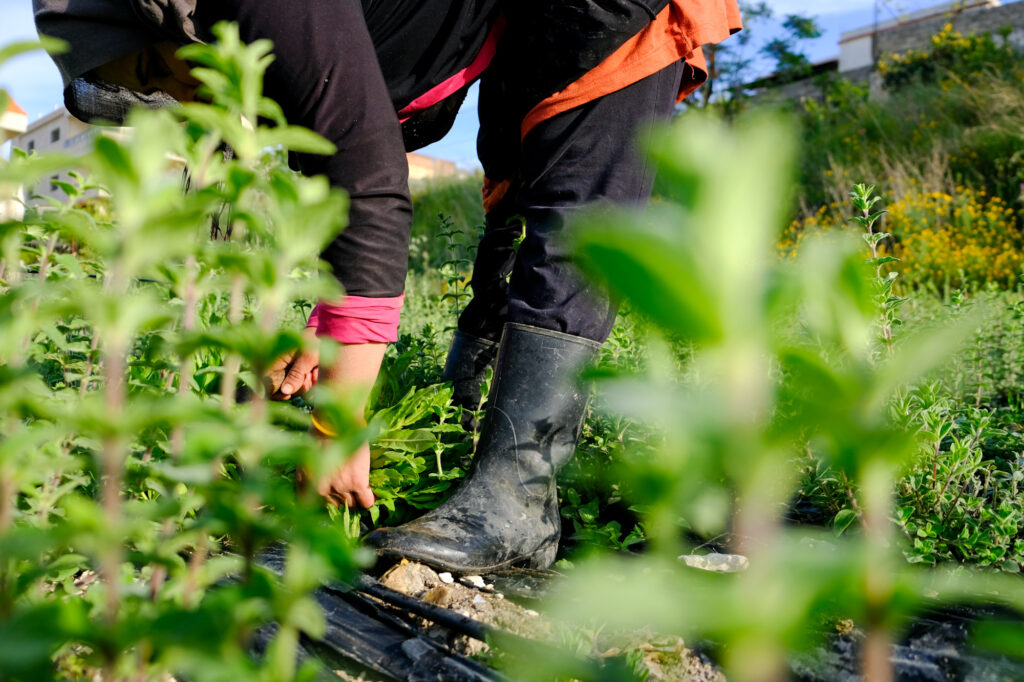
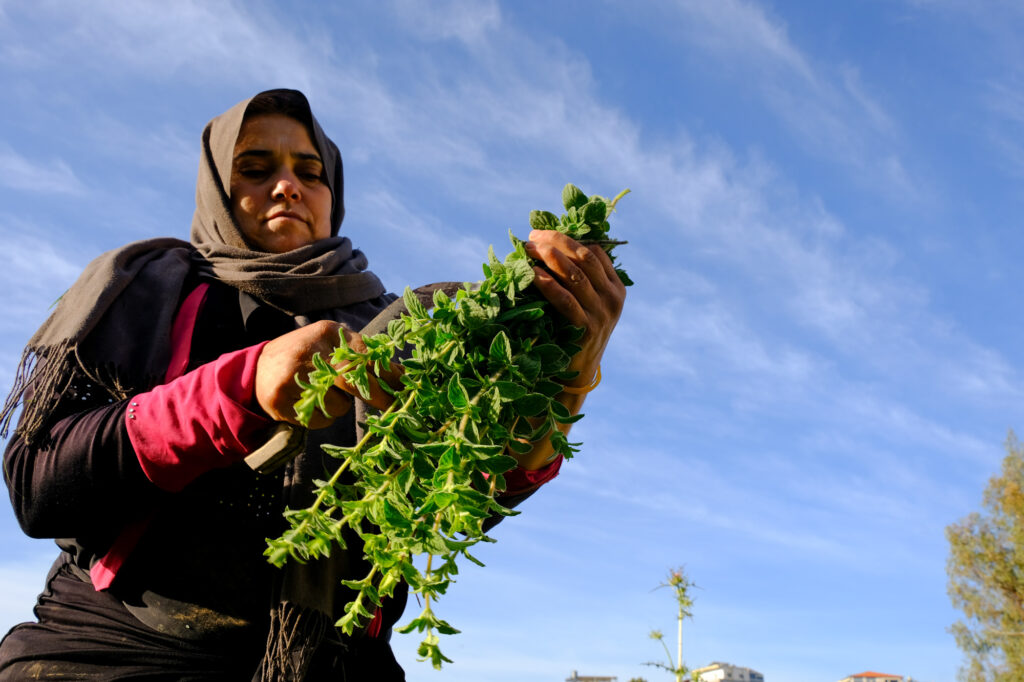
“It is hard work. You need to do a lot of preparation, from tilling the soil and setting up proper irrigation to placing the plants with enough space to let them grow well,” Majida says.
She points to the ground around her, where strips of black nylon have been laid out to retain soil moisture and prevent too many weeds from taking root.
A bit further away, in the midst of filling one last box with zaatar, is a woman who goes by the name Um Ibrahim, working alongside her daughter. They come from Aleppo in Syria, but have lived and worked in southern Lebanon for many years.
“We have worked with the cooperative for three years. Otherwise, we often work in tobacco. There’s a lot of tobacco here,” Um Ibrahim says.
“But zaatar is easier to harvest. With tobacco, you have to start very early, at four or five in the morning, and pick it leaf by leaf.”
Um Ibrahim and her family fled, like so many others, when the south was bombed. Among the 900,000 displaced by the war were not just Lebanese, but also families from Syria, working with things like construction and agriculture across the south, as well as people from Sudan, Bangladesh, Ethiopia, and countries in West Africa, living and working here.
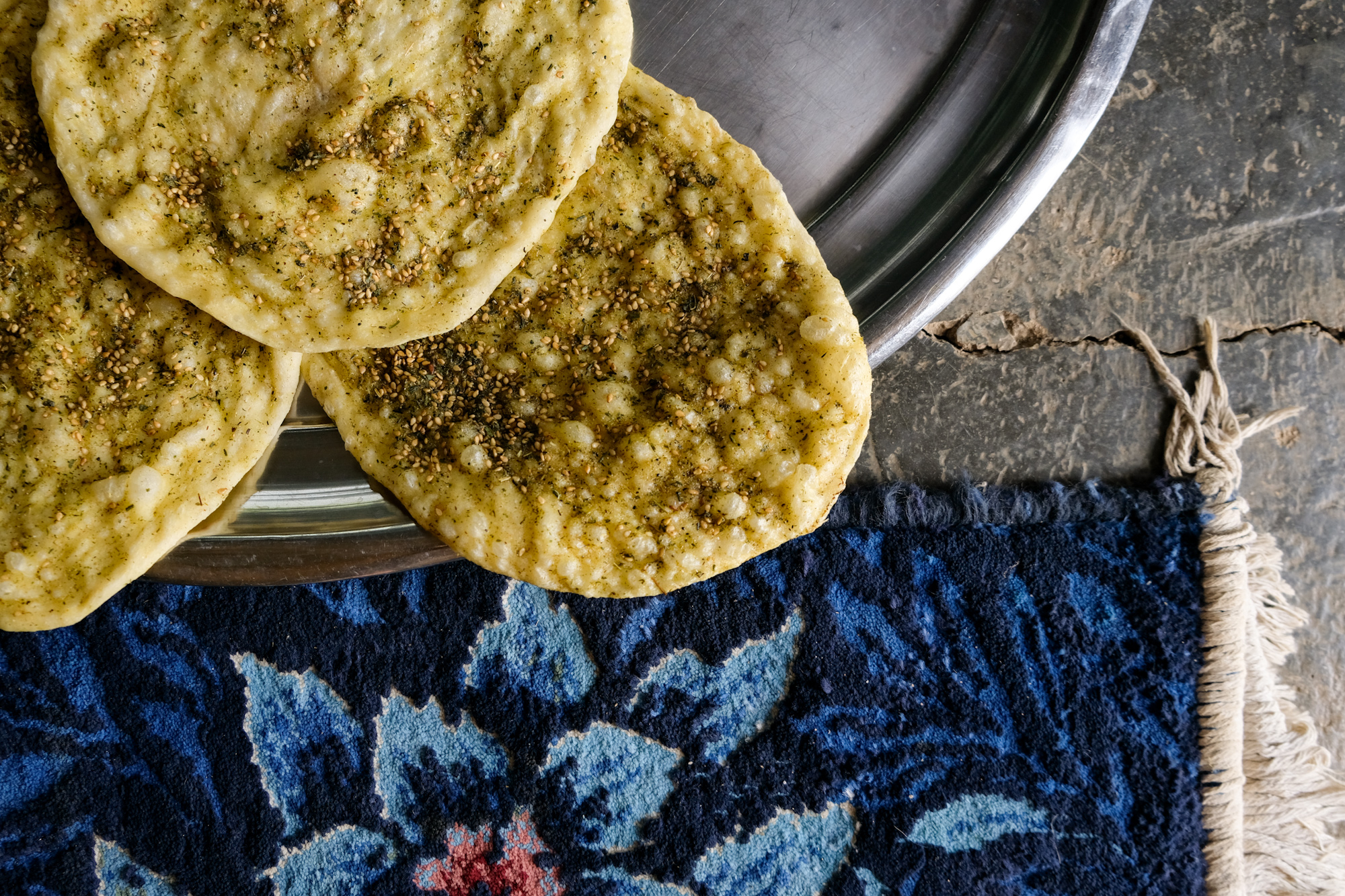
Zaatar is typically eaten on manouche bread, baked in large ovens or on metal saj griddles
The death toll from the war continues to grow. In December, one week after the ceasefire agreement came into place, Lebanon’s health minister, Firass Abiad, said that 4,047 people had been killed in Israeli attacks. In April, the UN’s OHCHR reported that at least 71 civilians had been killed after the ceasefire deal was signed, a number that continues to grow.
Israeli attacks have killed several shepherds and fishers, and on May 1, five months into the ceasefire, Oussama Farhat, an environmentalist known for his work caring for wild animals, was also killed.
Facing all of this, the women in Qana are uncertain about the future.
“When we came back from the war, I had a lot of emotions. I even told the others, ‘Let’s shut down the cooperative.’ For two years, nothing moved for us, and our savings were stuck. I kept asking myself, ‘Why are we doing this?’” Majida says.
Then, they started thinking about trying out a new product: distilled zaatar, which can be bottled and added to tea or juice to help strengthen the immune system and relieve cough and cold.
“We already have some plants we will try this with. We have saved leftover parts and stems,” Majida says.
Wild plants, including varieties of zaatar, have been used in folk medicine throughout history. Oregano and thyme are rich in thymol, an essential oil, and carvacrol, a phenol (an aromatic organic compound), which have antioxidant and antiseptic properties. In Lebanon, Palestine, and the surrounding region, zaatar is perhaps most known for one particular benefit: it sharpens the brain. The day before an exam, children will typically be told by their parents to drink or eat zaatar.
In Jezzine, Afife and her children walk out onto the terrace at the back of the house they are renting. There is a small piece of land next to it, where they grow different vegetables. They have to try new methods and crops, since Jezzine is at a high altitude. In the meantime, until they return to Kfarkela, Ali continues sharing videos of his mother on the land – planting, harvesting, cooking, and preserving.
